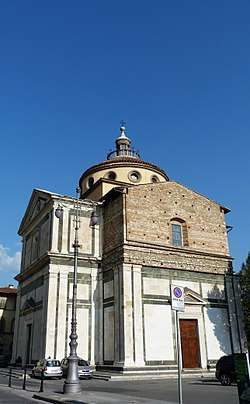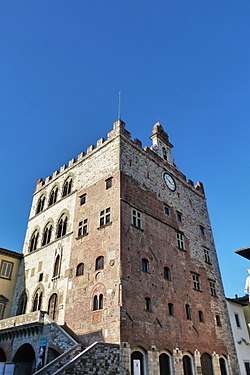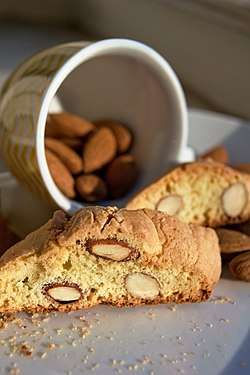Prato
| Prato | ||
|---|---|---|
| Comune | ||
| Comune di Prato | ||
 | ||
| ||
 Prato Location of Prato in Italy | ||
| Coordinates: 43°52′48″N 11°05′54″E / 43.88000°N 11.09833°ECoordinates: 43°52′48″N 11°05′54″E / 43.88000°N 11.09833°E | ||
| Country | Italy | |
| Region |
| |
| Province | Prato (PO) | |
| Frazioni | See list | |
| Government | ||
| • Mayor | Matteo Biffoni | |
| Area | ||
| • Total | 97.35 km2 (37.59 sq mi) | |
| Elevation | 65 m (213 ft) | |
| Population (31 December 2017) | ||
| • Total | 193,325 | |
| • Density | 2,000/km2 (5,100/sq mi) | |
| Demonym(s) | Pratesi | |
| Time zone | UTC+1 (CET) | |
| • Summer (DST) | UTC+2 (CEST) | |
| Postal code | 59100 | |
| Dialing code | 0574 | |
| Patron saint | St. Stephen | |
| Saint day | 26 December | |
| Website | Official website | |
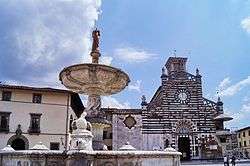
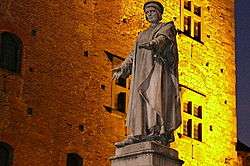
Prato (Italian pronunciation: [ˈpraːto] (![]()
With more than 193,000 inhabitants, Prato is Tuscany's second largest city and the third largest in Central Italy, after Rome and Florence.
Historically, Prato's economy has been based on the textile industry. The renowned Datini archives are a significant collection of late medieval documents concerning economic and trade history, produced between 1363 and 1410.[1]
The famous cantucci, a type of biscotti, was invented here during the Middle Ages and they are still produced by local old bakers.
History
Ancient times
Archaeological findings have proved that Prato's surrounding hills were inhabited since Paleolithic times. The plain was later colonized by the Etruscans. In 1998 remains of a previously unknown city from that civilization were discovered in the neighbourhood of Gonfienti near Campi Bisenzio. It was of medium size and it was already a centre for the wool and textile industry. According to some scholars, it could be the mythical Camars. The Etruscan city was inhabited until the 5th century BC, when, for undisclosed reasons, it decayed; control of the area later shifted to the Romans, who had their Via Cassia pass through here, but did not build any settlement.
Middle Ages
In the early Middle Ages, the Byzantine and Lombard dominations prevailed in the region.
The history of Prato itself begins from the 10th century, when two distinct villages, Borgo al Cornio and Castrum Prati (Prato's Castle), are known. In the following century the two settlements were united under the lords of the castle, the Alberti family, who received the imperial title of Counts of Prato. In the same period the plain was dried and a hydraulic system regulating and exploiting the waters of the Bisenzio River was created to feed the gualchierae (pre-industrial textile machines).
After a siege in 1107 by the troops of Matilde of Canossa, the Alberti retreated to their family fortresses in the Bisenzio Valley: Prato could therefore develop as a free commune. Within two centuries it reached 15,000 inhabitants, spurred in by the flourishing textile industry and by the presence of the Holy Belt relic. Two new lines of walls had to be built in the mid-12th century, and in the early 14th century.
In 1326, in order to counter the expansionism of the Republic of Florence, Prato submitted voluntarily under the seigniory of Robert of Anjou, King of Naples. However, on 23 February 1351 Joanna I of Naples sold the city to the Republic of Florence in exchange for 17,500 golden florins.
Prato's history therefore followed that of Florence in the following centuries.
Modern age
In 1512, during the War of the Holy League, the city was sacked by Spanish troops assembled by Pope Julius II and the king of Aragón, Ferdinand II, to recover the nearby city of Florence for the Medici family. The severity of the sack of Prato led to the surrender of the Florentine Republic, and to the restoration of the Medici rule. Historians debate the actual number of people killed during the sack, but contemporary chroniclers asserted between 2000 and 6000 people were slaughtered in the streets.
In 1653 Prato obtained the status of city and became seat of a Catholic diocese. The city was embellished in particular during the 18th century.
After the unification of Italy in the 19th century, Prato became a primary industrial centre, especially in the textile sector (Italian historian Emanuele Repetti described it as the "Italian Manchester"), and it population grew up to 50,000 in 1901 and to 180,000 in 2001. The town experienced significant internal immigration. Previously part of the province of Florence, in 1992 Prato became the capital of the eponymous province.
Main sights
Prato is home to many museums and other cultural monuments, including the Filippo Lippi frescoes in the Cathedral of Santo Stefano, recently restored. The Cathedral has an external pulpit by Donatello and Michelozzo, built and still used for the display of the cathedral's famous relic of the Virgin Mary, the Girdle of Thomas (Sacra Cintola, a cord belt), which had a great reputation in the late Middle Ages and is often shown in Florentine art. Also of interest is the Teatro Metastasio, the city's main venue for operas and other theatrical productions, which was built in 1829–30.
Palazzi and castles in the historical center
- Palazzo Pretorio. The palace was begun in the 13th century in red bricks; late-Gothic style additions were in white stone. The external staircase and clock were added in the 16th century and later.
- Palazzo Datini, built from 1383 for the merchant Francesco Datini. It was decorated by Florentine artists like Agnolo Gaddi and Niccolò Gerini. In 1409 it housed Pope Alexander V and Louis of Anjou.
- Palazzo degli Alberti (13th century), housing a museum with works by Filippo Lippi (Madonna del Ceppo), Giovanni Bellini (Crucifix with Jew Cemetery) and Caravaggio (The Crowning with Thorns).
- Castello dell'Imperatore. Located in the city center, this is the northernmost castle built by Frederick II of Hohenstaufen in Italy.
Main churches in the historical center
- Prato Cathedral, one of the most ancient churches in the city, already in existence in the 10th century. It was built in several successive stages in the Romanesque style. The church contains a number of notable works of art, in particular fine sculpture.
- Santa Maria delle Carceri. Commissioned by Lorenzo de' Medici to Giuliano da Sangallo in 1484. It is on a Greek cross plan, inspired by Brunelleschi's Pazzi Chapel. Works lasted for some twenty years. The interior is run by a bichromatic maiolica frieze by Luca della Robbia, also author of four tondos depicting the four Evangelists in the cupola. The external façade is unfinished, only the western part being completed in the 19th century according to Sangallo's design.
- Sant'Agostino: built from 1440 over an existing edifice from 1271. It has a simple façade with a rose window and a bell tower with pyramidal top. The interior is on the basilica plan, with a nave and two aisles divided by brickwork columns having "waterleave" capitals (c. 1410). The apse chapels date to the late 14th century. The interior is home to canvasses by Giovanni Battista Naldini, Lorenzo Lippi, l'Empoli, Giovanni Bizzelli and others, as well as 14th-century frescoes. The cloister dates to the 16th century.
- San Domenico. The interior altars house a crucifix of the 14th century and an Annunciation by Matteo Rosselli (1578-1650). The cloister of the adjacent convent was built in 1478-80. An adjacent museum has works of wall frescoes.
- San Francesco. It houses a funerary monument of Geminiano Inghirami (died 1460), and the frescoes by Niccolò Gerini in the wonderful Cappella Migliorati.
- San Fabiano, already existing in 1082. It houses precious traces of a pavement mosaic dating from the 9th-11th centuries. Also notable is the 15th-century bell tower.
- Minor Basilica of Santi Vicenzo e Caterina de' Ricci: Adjacent to the late-Baroque monastery of San Vicenzo. The church was decorated for the canonization of the Saint Catherine of Ricci, who was associated with the monastery and is buried in the church.
Main museums
- Palazzo Pretorio. It was the old city hall located town center, standing in front of the current Palazzo Comunale. It now accommodates the Civic Museum of Prato, which was reopened on September 2013.
- Prato Cathedral Museum. It was founded in 1967 in a few rooms of the Bishop's residence and in 1976 grew to include items from both the Cathedral of Saint Stephen and the diocesan territory.
- Centro per l'arte contemporanea Luigi Pecci, devoted to the contemporary arts of the last three decades. The complex composes the Museum of Contemporary Art, the Centre of Information and Documentation, including the visual arts, and an education department.
- Prato textile museum. The museum and library is an Anchor point on the European Route of Industrial Heritage.
- Galleria di Palazzo degli Alberti, home to the art gallery of the local bank (former Cassa di Risparmio di Prato). Works of the collection include The Crowning with Thorns, by Caravaggio (c. 1604).
- Museo della Deportazione dedicated to the history of Fascism’s occurrence and rise to power in Italy.
Music collections
Sport
Education
Higher-education institutions include Il Polo Universitario "Città di Prato" (a branch of the Università degli Studi di Firenze)[2] and the Monash University Centre which is located in the Palazzo Vai.[3] The University of New Haven opened a satellite campus in Prato in 2012.
Notable citizens
- Nicolo Albertini, 13th-century cardinal
- Lorenzo Bartolini, sculptor
- Sem Benelli, writer
- Roberto Benigni, actor and director
- Francesca Bertini, actress
- Antonio Brunelli, composer
- Clara Calamai, actress
- Ferdinando Castagnoli, archaeologist
- Jury Chechi, gymnast, olympic gold medalist
- Enrico Coveri, fashion designer and entrepreneur
- Francesco Datini, 14th-century merchant
- Alessandro Diamanti, soccer player
- Ignazio Fresu, sculptor
- Emilia Goggi, opera singer
- Filippino Lippi, 15th-century painter
- Fiorenzo Magni, cyclist
- Curzio Malaparte, writer
- Filippo Mazzei, politician
- Francesco Nuti, actor
- Iva Pacetti, liric singer(soprano)
- Rachele Risaliti, Miss Italia 2016
- Paolo Rossi, soccer player
- Christian Vieri, soccer player
- Pamela Villoresi, actress
- Domenico Zipoli, composer
Climate
Prato has a humid subtropical climate which has sunny hot summers and cool damp winters. July is the driest month of the year.
Transportation
- Prato Porta al Serraglio railway station
- It is situated in the historical center of the town and connects to Florence in about 25 minutes with the Viareggio–Florence railway.
- Prato Centrale railway station
- It was opened in 1862, is the biggest station in Prato. It forms part of both the Bologna–Florence railway and the Viareggio–Florence railway.
Dialect
The dialect from Prato is very similar to that of Florence, but it has its own peculiarities. The pronunciation of the city name in the dialect was traditionally [ˈpraː.o] but now [ˈpraːho] or [ˈpraːθo] are more common.
Chinese immigration
The city of Prato has the second largest Chinese immigrant population in Italy (after Milan with Italy's largest Chinatown). Legal Chinese residents in Prato on 31 December 2008 were 9,927.[4] Local authorities estimate the number of Chinese citizens living in Prato to be around 45,000, illegal immigrants included.[5] Most overseas Chinese come from the city of Wenzhou in the province of Zhejiang, some of them having moved from Chinatown in Paris. The first Chinese people came to Prato in the early 1990s. The majority of Chinese work in 3,500 workshops in the garment industry and ready-to-wear. Chinatown, known as Santo Beijing[6], is located in the west part of the city, spreading to Porta Pistoiese in the historical centre. The local Chamber of Commerce registered over 3,100 Chinese businesses by September 2008.[7] Most of them are located in an industrial park named Macrolotto di Iolo. Raids on factories employing illegal immigrants in 2010 highlighted problems with the growth of an apparel industry in Prato based on cheap, and sometimes illegal, labor.[8] In spite of all these blames, the local unemployment rate was around 7% in 2013, which was significantly lower than the national average 11%, even after 4,000 enterprises which employed 20,000 people were closed in the past two decades. The president of the Industrial Association of Prato, Andrea Cavicchi, pointed out that the local economic performance was much better than the rest of Italy due to those Chinese textile business.[9]
As of 2009, the Italian and Chinese populations did not socially mix. As of that year, there were 30,000 legal Chinese immigrants, and authorities believed there was a similar number of illegal Chinese immigrants.[10]
International relations
Prato is twinned with:
|
|
See also
References
- ↑ Archived March 7, 2009, at the Wayback Machine.
- ↑ "Il Polo Universitario "Città di Prato"". Poloprato.unifi.it. Retrieved 2011-04-05.
- ↑ "Monash University Prato Centre". Ita.monash.edu. Retrieved 2011-04-05.
- ↑ "Prato in cifre: gli stranieri residenti a Prato - suddivisione per cittadinanza" (in Italian). Comune.prato.it. 2008-12-31. Archived from the original on 2011-02-24. Retrieved 2011-04-05.
- ↑ "Notizie, informazioni della regione Toscana". Intoscana.it. Retrieved 2011-04-05.
- ↑ "View from Italy: The People’s Republic of Prato" article by Anna Blundy in Prospect Magazine March 14, 2017, accessed August 17, 2018
- ↑ "Ufficio Statistiche e prezzi - Imprese straniere - Imprese per nazionalità forma giuridica e settore" (in Italian). Po.camcom.it. Retrieved 2011-04-05.
- ↑ "Chinese Remake the ‘Made in Italy’ Fashion Label" article by Rachel Donadio in The New York Times September 12, 2010, accessed September 13, 2010
- ↑ The Rupp Report: Chinese "Made In Italy" article by Jürg Rupp in "Textile World", December 10, 2013, accessed December 15, 2014
- ↑ Spolar, Christine (2009-01-02). "Chinese immigrants transform Italy's fashion industry". Chicago Tribune. Retrieved 2016-12-24.
- ↑ "Fraternity cities on Sarajevo Official Web Site". City of Sarajevo 2001-2008. Retrieved 2008-11-09.
Bibliography
- See also: Bibliography of the history of Prato
External links
| Wikivoyage has a travel guide for Prato. |
- Culture in Prato
- Exhibition Da Donatello a Lippi. Officina Pratese at Museo Civico di Palazzo Pretorio in Prato (September 2013 - January 2014)
- Information about Prato, Free Time Guide on Prato (in Italian)
- Complete Image galleries of the town, the medieval historic centre, churches and the Chinese quarter (in Italian)
- Chinese Remake the 'Made in Italy' Fashion Label
- A City Transformed - slideshow by The New York Times
- Prato on Encyclopædia Britannica
| Wikimedia Commons has media related to Prato. |

